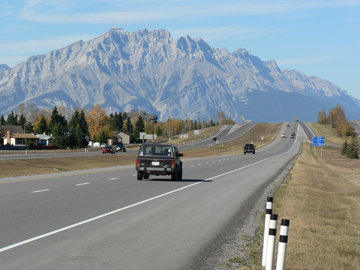Project leader: Marcello Vitali-Rosati
Project coordinator: Servanne Monjour
Team: Erwan Geffroy, Julie Tremblay-Dévirieux, Marie-Christine Corbeil.
External ressources
- The travel journal by Marcello Vitali-Rosati
- The Postcards From Google Street view by Servanne Monjour
- The augmented map on Open Street Map
- The photographies by Erwan Geffroy
- The presentation in Calgary

Project description
The Trans-Canada Highway, the legendary road that crosses Canada from the west coast to the east coast, has resulted in a series of media productions: literary stories, images, videos, maps, historical texts and digital data (digital maps, Wikipedia files, etc.). In May 2016, our research lab (Theolinum, a lab for the Canada Research Chair on Digital Textualities) will cross Canada along the Trans-Canada Highway to add our own travel experience to all of these mediations. We ask the question: What is the nature of this space? What does it represent and how do we think of it?
Today, our first reflex is indeed to search among all of the information available on the web, which includes historical information, images, stories and maps. Thus, this relatively empty physically space (the traditional sense of a map), when experienced both physically by travel and in a mediated way by the web, quickly “fills” with a series of values, symbols and cinematographic references, as well as literary, historical and patriotic narratives. We therefore ask ourselves if it is possible, to borrow from Perec who tried the experiment in Paris, to exhaust all the possibilities relating to the Trans-Canada imaginary, as an entity that exists both geographically and within the collective imaginary thanks to its virtual possibilities. On a more theoretical level, what would this exploration mean? Would it indeed be a form of hyper-representation—an account of the minutest details of what factually exists in this space—or, on the contrary, an activity of reality production?
To answer these questions, we propose to reveal the Trans-Canada space by questioning it on several levels. On the one hand, we will experience it through a road trip from Montreal to Calgary. We will also, on the other hand, document and retell our journey through a series of digital tools (writing online, photos, videos).
The hypothesis that we seek to prove is the following: the digital is as much a tool of representation as it is a production of the space in question. It indeed seems to us undeniable that our vision and experience of a territory such as Trans-Canada—as well as our way of organizing it by writing about it and by producing content relating to it—are deeply structured by digital tools and their layouts: that is, the different sources, the interactive maps and all the information, data and documents that we find on the web. In other words, our way of thinking about this space and considering it involves the (often unconscious) mediation of the tools that map it, describe it and narrate its existence by filling it with images, stories and information.